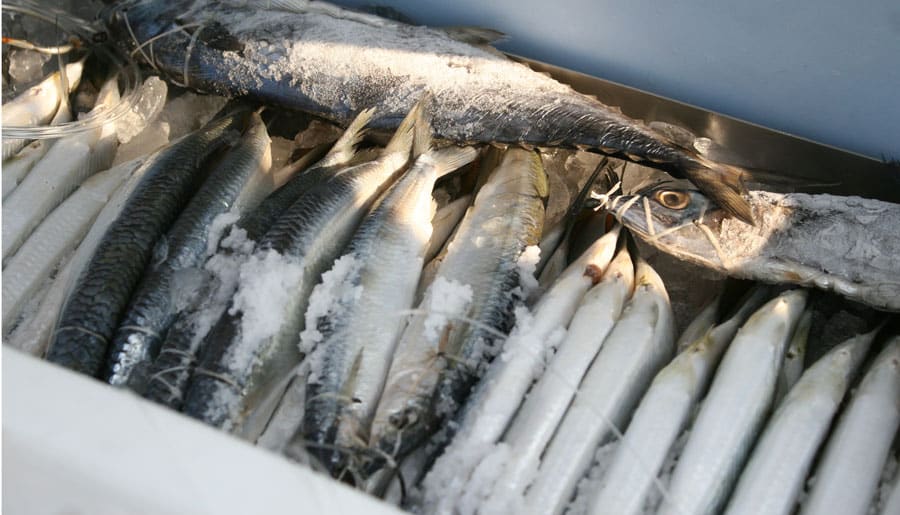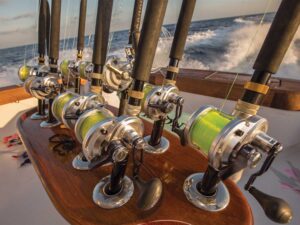
dead bait fishing
My short, new angling career has been a very interesting learning experience as well as a very humbling one. I now qualify to fish almost any tournament, having not been a paid crew member for more than 15 years. I’ve been able to be an angler on my 30-foot Grady-White and on other boats like Reel Tight, Pescadora and Lady Colombo, among others. After setting multiple IGFA records as a captain, and instructing numerous anglers to world-record catches over the years, you’d think that you would get used to working under pressure. But grabbing the rod with a blue marlin or a sailfish chasing the bait during a dead-bait trolling tournament still makes me nervous. And I’m not alone in that respect.
Seasoned tournament angler Rob Ruwitch of Sharky’s Revenge fished the old Billfish Extreme Release League tournament series with ESPN cameras in his face and over his shoulder, as well as many other big tournaments. He says that he feels the pressure when it’s his turn and the captain and crew are counting on him. I know that when I miss a fish, I feel a ton of pressure and a bruised ego on top of it. It is so much easier to shake off the mistakes or just plain misses when fun fishing.
**
What’s Your Job?**
What can you do to do your part? Start by doing what the mates do, and stay right by the rods all day. And help put out the baits — by free spooling each bait to its position, the angler gets acquainted with the rod and reels and becomes familiar with which bait is on what rod and where it should go in the spread. In the beginning, you may feel that you’re a hindrance, but you’ll get faster with practice, and everyone will appreciate the help. Let the mate attach the line to the rigger clip just in case you get a bite during this action. There’s nothing worse than getting caught with the reel engaged while you have the line in your hands, and the rod is sitting in the rod holder. That’s probably going to be a sancocho.
Reel in the baits when they need to be checked. This gets you used to moving the bait through the spread with the wind conditions of that day. If you’re the one checking and changing out baits, when the fish comes up you will automatically know which rod is attached to the bait that the fish is on, and you’ll be used to getting a single bait out through the spread. Sometimes you need to reel a bait in to get it to a fish, and this helps with that too.
Working the baits also allows you to become familiar with the position and the sensitivity of the drag lever and the balance of the rod and reel — important factors in becoming a good angler. Even being able to levelwind the reel without looking is very important. There is nothing worse than piling up the line in one spot and jamming up the spool with a fish just inches from release.
When our boat is not getting bites, and other boats around us are getting bites, that’s when it’s time to check the baits. Think about it. There are four or six baits out there all doing the same speed, maybe even all swimming, and now you start reeling in a single bait. It starts skipping and leaping out of the water. It starts making noise and acting like a baitfish would act if a billfish were chasing it in the wild. Watching showers of ballyhoo in the Keys will teach you a lot! That bait wants to get the heck out of there! This action could trigger a bite.
Checking the baits in this manner is akin to the “prospecting” that some sailfish experts deploy. Anglers prospect by dropping baits back in free-spool to make them look like dying baitfish, and that’s easy pickings. By dropping back and reeling a single bait back up over and over, some teams claim that they get as much as 25 percent of their bites with this method. Prospecting will also teach you how to drop-back, because you really have to use little to no thumb pressure to let it sink properly. You want that line pouring off the rod tip straight into the water behind the boat. Once you can do that, and still detect the pickup, you’ve got a lot of guys beat.
The Chase Scene
Once, while fishing off Venezuela on the Hooker, I was up in the tower slow-trolling live baits around the bank when I saw a houndfish running for its life with another fish in hot pursuit. As I got closer, I could see that it was a blue marlin that was hot on the houndfish’s tail, and an incredible chase scene developed right in front of me. Every time the marlin approached the houndfish, the houndfish would take flight, bounding away about 20 yards or so in the opposite direction. I felt very privileged to be watching the whole thing play out and saw about six to eight of these chase scenes before the marlin finally grabbed the houndfish.
It was at this point that it became really interesting. The marlin had the houndfish crosswise in its mouth, like a dog with a bone. As it swam along at about 3 knots, I turned the boat to follow it. The marlin swam about a hundred yards or so before I saw it stop, shake its head and then start swimming again. After the head shake, I could no longer see the color of the houndfish around the face of the marlin.
The one unique characteristic of ballyhoo and houndfish that I found in examining the contents of the stomachs of billfish many years ago is that you will find the bait in different directions and folded over. With most other baitfish (goggle-eyes, small bonito, etc.), the baits tend to lay headfirst in the stomach. When eating smaller baits, a billfish can do a quick head shake and turn it, so it is directed headfirst toward the gullet. And while the baitfish wiggles its tail to escape, it actually swims itself into the stomach. Guy Harvey has filmed a lot of this, and you can actually see it on film now. With a squirmy ballyhoo or houndfish, billfish have to force it down their throat after it’s been squeezed to death. Even in a swordfish, you find a lot of the squid in one direction in their stomachs.
It was only a few years ago that we all used skipping ballyhoo, and then it seemed we all went to swimming baits. We got plenty of bites with those skipping baits, so why doesn’t anyone use them now? I think a few boats do without knowing it. By trolling fast, they will get a few of their baits to jump and skip occasionally. Some crews also put too much weight under the bait’s chin, which can hurt you on the drop-back if the bait sinks too fast. Sort of like a mullet with a big chin weight; it’s a great-looking bait, but it’s got a lousy hookup ratio. Maybe that’s why we only use them for teasers nowadays
Billfish expect a live bait to take off when they get near it. That’s why it’s so important to be able to drop the bait in the fish’s mouth when they stick their head up behind your trolling bait. You want to get that bait inside of the billfish’s mouth. If you let the fish bite it, they try to squeeze the life out of the bait before swallowing it. They want to kill it so they don’t have to chase it again. Then they release their grip enough to suck it down.
Unfortunately, if you don’t wait until the fish swallows the bait and engage the reel while the fish is still squeezing the bait to death, the bait tears in half and you get to reel in the head. Another sancocho!
**
The Drop-Back**
Get your rod tip up! You hear this from a lot of captains and crews. It accomplishes two things; it gets the line out of the water and brings the bait up on the surface so you can see the fish behind the bait. Getting the tip up helps immensely when using swimming baits as well.
When you see the fish start to come up on the bait, don’t be afraid to lift the bait away from the fish just a little bit more. When you see the fish attempting to eat the bait, you can drop the rod tip fast, free-spool the reel with the lightest pressure possible, and let the bait fall into the billfish’s mouth. You just increased your odds of hooking the fish by a large margin.
When a fish is chasing a bait that I’m reeling in, as I take my last crank I continue to lift the rod, which keeps the bait away from the fish and gets the rod tip up. As you lift the rod, you move your hands into position to free-spool the reel when you drop that tip. If you just stop reeling, and then try to get the reel into free-spool, the billfish usually grabs the bait. By the time you pull the drag lever back, there is already too much pressure on the line and you end up with a nice backlash.
Switching from winding to free-spool on a bite is pretty hard to do on the long rigger baits, especially when some boats are fishing them back in another zip code. Having line in the water, and the resulting drag it creates, is the biggest problem with any bite, but especially with the long rigger bites. When a fish bites one of those long rigger baits and all that line falls into the water, even a good drop-back won’t mitigate the water’s drag on the line, which the fish can feel.
How much difference does that extra line in the water make? I think that if you can catch just over 50 percent on the extra-long rigger bites, 75 percent on the short riggers and 85 percent on the flat lines, then you would be reaching world-class ratios.
One of the big mistakes I see a lot of anglers make on the drop-back is applying too much thumb pressure on the spool. That extra little bit of resistance rewards you with many misses and a nice collection of ballyhoo heads. If the line isn’t falling off the rod tip when you’re dropping back, you’re doing it wrong.
Back when we used J hooks, many anglers would push the drag up to strike and jerk the rod to hook the fish — and a lot of guys still forget and haul back with circle hooks as well. When we were teaching guests how to hook fish on the Hooker, we never told anyone to set the hook. Instead, we’d tell them to engage the drag and then start to reel to get the line tight. This accomplishes one of two things: You either get tight to a hooked fish, or the bait starts to get back up to the surface and in position for another shot.
If a live bait escapes from a billfish in the wild, it would try and take off, and most likely the billfish would track it down again. If you jerk the rod and the billfish isn’t there, you could ruin the bait. The bait would either come apart, or most likely end up spinning a lot because of the way we rigged the baits with a J hook in the belly of the bait. In short: Don’t jerk the rod.
**
Applying Appropriate Pressure**
Some captains and crews will have you reel the bait up quite a ways for a couple of different reasons. One is to get some of that line out of the water to help you hook the fish once it eats. Another is for the captain to see if the fish is still chasing the bait. The fish’s size and species can be important, depending on what tackle you are using. At the same time, the captain and crew are also trying to see how much bait is left on the hook after a missed strike. Reeling the bait in may also get the billfish into a more aggressive mood as it sees the bait trying to get away. Once the fish regroups after a miss and starts following your bait back to the boat, it is time to get that rod tip up and get ready to drop back again.
The next mistake often made is pushing the drag up too far on the reel when you are ready to come tight to the fish when you are using circle hooks. The worst thing you can do is put too much pressure on a circle hook. Two to 3 pounds of pressure is all you need, and 8 to 10 pounds of drag is usually too much. After you give the fish that perfect drop-back and count to whatever your number is (the captain and crew will tell you to count to three or four), then really concentrate on just barely pushing the drag lever up to start the engaging action.
You have no idea which way that fish is going, and the last time you saw the fish, it was swimming at you, chasing your bait, which is the worst angle. You really need that line and leader to stay behind the fish. So, by pushing the drag up slowly and not putting too much drag on the line, you are hoping the line “trails” behind the fish as it comes tight and the circle hook finds its spot in the corner of the fish’s mouth. Once you push the drag up to “strike,” you can wind slowly or even put the rod tip in the water. This creates instant pressure on the line, just like reeling.
Pushing the drag lever up too far pulls the line tight instantly, and if the fish is swimming right at the boat when the line comes tight, you run a good chance of pulling the hook straight out of the fish’s mouth. And, again, this is where all the practice of letting the baits out and reeling them in comes into play. In time, applying the proper amount of drag pressure will become instinctive.
Once I think that I have hooked the fish (line is peeling off the reel), I initially like to leave the drag kind of light, for two reasons. First, it allows the other anglers a chance to hook any other fish that may be in the spread. I believe that one feeding fish — or even a jumping fish — attracts other fish. That’s why we’ve learned to circle the hooked fish and wait for the others to show up.
Second, as the hooked fish takes off on its initial blistering run, the last thing you want to do is apply too much drag and break the line. It’s much better to be patient and let the fish take some line and settle down than to reel in a broken line and feel the wrath of your peers. Broken lines are for the practice day. After you hook a fish on the practice day, it’s OK to see how much pressure you can put on the tackle, so in case you get that stubborn sail or blue marlin, you’ll know what it takes to max out your line.
The other reason to use a light drag initially is that you really don’t need to apply heavier drag until later in the fight. When you have a lot of line out and there’s a belly in the line, you can sometimes put too much drag on standard light-wire circle hooks. The hook will almost straighten and then pull out. When you reel in that empty hook, you’ll think you just didn’t hook the fish right when in fact you did hook the fish, but the light wire straightened for a second, pulled out and then returned to its original shape. So, the question is, what do you have to lose by leaving the drag light? Nothing but the fish!
I hear a lot of people at the end of the tournament tell me that they had plenty of bites but just couldn’t hook the fish. Besides angling skill, the other factors making a successful hookup could be the reels you use (the inertia it takes to free-spool), the leader material, the way the baits are rigged and the freshness of the bait. Then there are the stories of boats not seeing enough fish, and that leads us to the subject of those damn teasers used to attract the fish, and what kind of boats raise more fish. Which are both topics that would require another story. I could just take a shortcut and write one called “1,001 Ways to Lose a Fish” and take care of all of it in one shot!







